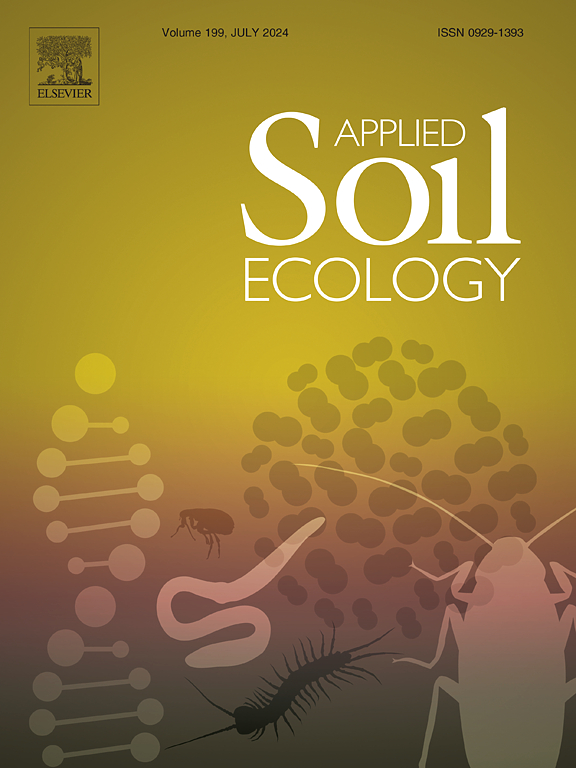IF 4.8
2区 农林科学
Q1 SOIL SCIENCE
引用次数: 0
摘要
土壤微生物易受土壤环境变化的影响,特别是养分缺乏的影响,并通过调整胞外酶的产生来应对养分限制。生物土壤板结(BSC)是表层土壤微生物和养分循环的介质,对土壤和微生物特性有重大影响。然而,在退化的喀斯特生态系统中,有关生物土壤板结对土壤微生物养分限制的影响的研究还很少。本研究以裸土为对照,重点研究了四个不同退化程度的岩溶生态系统中的苔藓结壳。我们收集并测量了表层土壤的理化性质和酶活性,量化了微生物养分限制,并探讨了影响这些限制的重要因素。结果表明,微生物碳(C)和氮(N)限制在退化的喀斯特生态系统中普遍存在(矢量长度,VL > 0.61,矢量角,VA <55°),随着退化程度的增加,碳限制加剧,而氮限制呈现单峰趋势。苔藓结壳的存在增加了C-(β-1,4-葡萄糖苷酶,BG)和N-(β-1,4-N-乙酰-葡萄糖苷酶,NAG,亮氨酸氨肽酶,LAP)获取酶的活性,总体上加剧了微生物对C和N的限制(p <0.05)。可用钾(AK)、土壤有机碳(SOC)、pH 值和全氮(TN)是对微生物养分限制影响最大的因素(p < 0.05)。这项研究加深了我们对退化喀斯特生态系统中土壤养分条件、微生物特征和苔藓结壳生态功能的了解,提高了对植物-土壤-微生物系统中养分生物地球化学循环的认识,为深入研究土壤微生物养分限制提供了新的见解。本文章由计算机程序翻译,如有差异,请以英文原文为准。

Ecoenzymatic stoichiometry reveals the exacerbation of microbial C and N limitations by moss crusts in degraded karst ecosystems
Soil microorganisms are susceptible to changes in soil environments, particularly nutrient deficiencies, and respond to nutrient limitations by adjusting the production of extracellular enzymes. Biological soil crusts (BSCs) serve as a medium for surface soil microorganisms and nutrient cycling, significantly affecting soil and microbial characteristics. However, research on the effect of BSCs on soil microbial nutrient limitations is scarce in degraded karst ecosystems. This study focused on moss crusts in four karst ecosystems with varying degrees of degradation, using bare soil as a control. We collected and measured the physicochemical properties and enzyme activities of surface soil, quantified microbial nutrient limitations, and explored significant factors affecting these limitations. Results showed that microbial carbon (C) and nitrogen (N) limitations were prevalent in degraded karst ecosystems (vector length, VL > 0.61, vector angle, VA < 55°), with C limitation intensifying as degradation degrees increased, while N limitation showed a unimodal trend. The presence of moss crusts increased C- (β-1,4-glucosidase, BG) and N- (β-1,4-N-acetyl-glucosaminidase, NAG, leucine aminopeptidase, LAP) acquiring enzyme activities, and overall exacerbating microbial C and N limitations (p < 0.05). Available potassium (AK), soil organic carbon (SOC), pH, and total nitrogen (TN) were the most influential factors in microbial nutrient limitations (p < 0.05). This study enhances our understanding of soil nutrient conditions, microbial characteristics, and the ecological functions of moss crusts in degraded karst ecosystems, improving knowledge of biogeochemical cycles of nutrients in plant-soil-microbe systems and offering new insights into deeper studies of soil microbial nutrient limitations.
求助全文
通过发布文献求助,成功后即可免费获取论文全文。
去求助
来源期刊

Applied Soil Ecology
农林科学-土壤科学
CiteScore
9.70
自引率
4.20%
发文量
363
审稿时长
5.3 months
期刊介绍:
Applied Soil Ecology addresses the role of soil organisms and their interactions in relation to: sustainability and productivity, nutrient cycling and other soil processes, the maintenance of soil functions, the impact of human activities on soil ecosystems and bio(techno)logical control of soil-inhabiting pests, diseases and weeds.
 求助内容:
求助内容: 应助结果提醒方式:
应助结果提醒方式:


